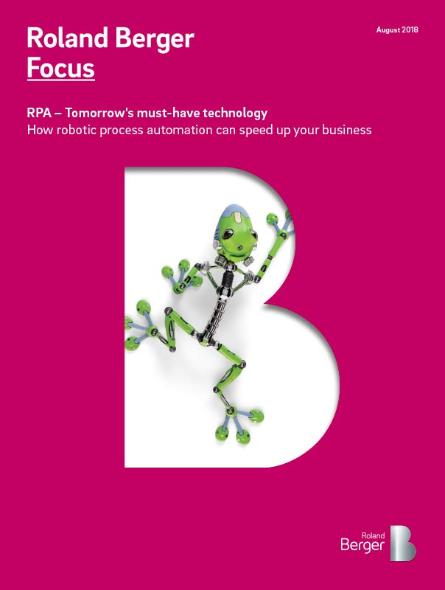RPA – speed up your business with robotic process automation
![{[downloads[language].preview]}](https://www.rolandberger.com/publications/publication_image/roland_berger_robotic_process_automation_cover_download_preview.jpg)
Robotic process automation is fast becoming a competitive necessity, across industries and corporate functions. Here's what you need to know about tomorrow's must-have technology.


Want to free up office staff from tedious tasks like data entry and repetitive copy and paste activities to focus on high value work? Robotic process automation has the potential to trigger the next revolution in business processes, enabling cost savings of up to 40 percent in some areas, with payback periods often as low as six months.
Essentially, a specialized software solution that simulates an employee – a robot – handles high-volume, routine and often dull operations that previously required humans to deal with. Its big advantage is that results are delivered much faster, more precisely and around the clock, 365 days a year.
Apart from being easy to use and configure, RPA solutions are compatible with most IT systems and do not require changes to a company's existing IT infrastructure, but can be quickly adapted to new systems, too.
RPA applications are constantly evolving, but they are best suited for standardized, stable processes that follow a rule-based decision logic. However, in line with the concept of "end-to-end process optimization", RPA can also support the automation of processes across departments, such as purchase-to-pay, order-to-cash, record-to-report or hire-to-retire processes.
Applications range from simple tasks such as generating an automatic response to an email to assisting the accounting department in statutory reporting or executing purchase requisitions in procurement. Other areas include invoice and payroll processing, customer data management, supplier management or even HR operations such as employee onboarding activities.
While RPA is already popular with functions such as finance and procurement as well as in banks and insurance companies, which offer largely non-physical goods and services, it is equally promising in other industries, in both administrative departments and operational business functions.
Overall, up to 40 percent of tasks in administrative departments and operational business functions have a significant RPA potential, our study has found. Firms can achieve annual savings of up to 40 percent of the respective costs and reductions in process time of 40-70 percent thanks to the automation of repetitive tasks. The payback period for implementing the new technology is highly attractive, often at just six months to a year.
For many companies RPA has become much more than a performance improvement tool that results in substantial cost savings. It has allowed staff to put more creative energy into higher-value tasks. Deploying the technology across functions has lit a digital spark among entire teams and departments. And, importantly, the scalability of RPA also creates great opportunities for startups with ambitious growth plans: RPA can help early-stage ventures scale up with fewer restrictions.
While RPA is quickly gaining ground across most industries, early movers can still gain a competitive advantage by moving fast. To fully leverage this promising new technology, companies need to understand what it is, recognize its benefits, and then decide how, where and when best to implement it. In our study we suggest a four-step approach to RPA implementation.

![{[downloads[language].preview]}](https://www.rolandberger.com/publications/publication_image/roland_berger_robotic_process_automation_cover_download_preview.jpg)
Robotic process automation is fast becoming a competitive necessity, across industries and corporate functions. Here's what you need to know about tomorrow's must-have technology.
